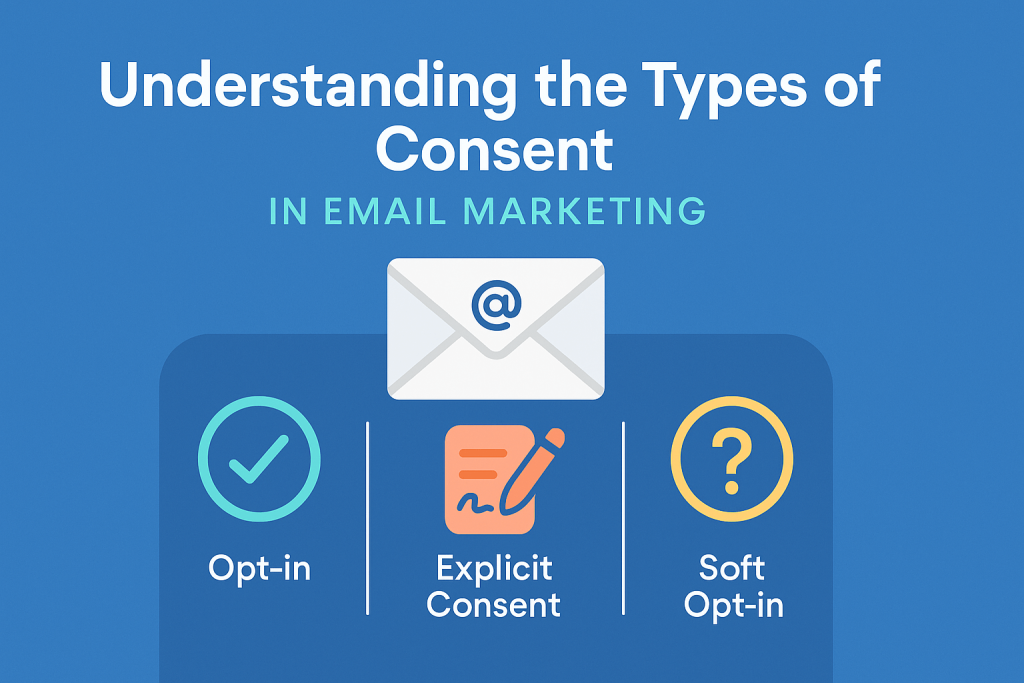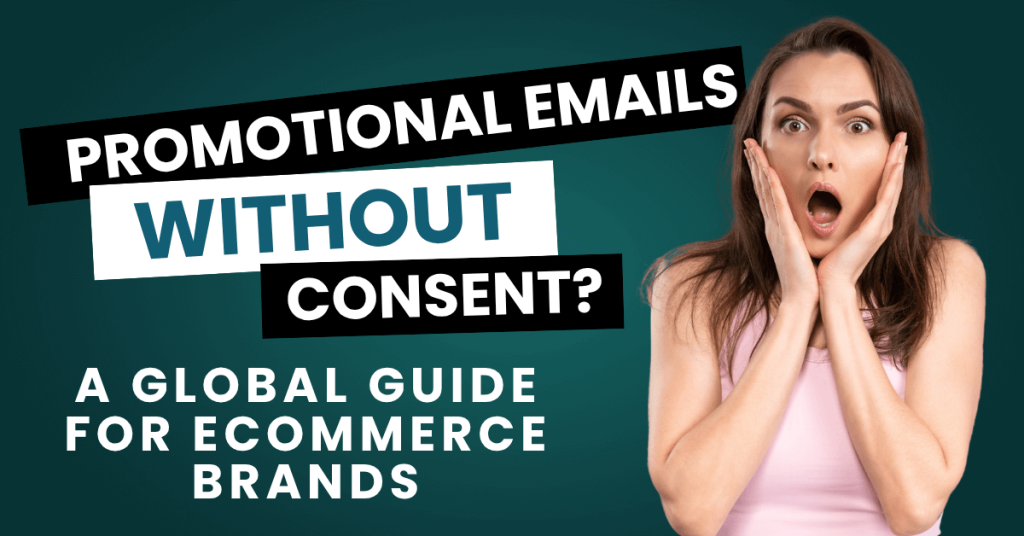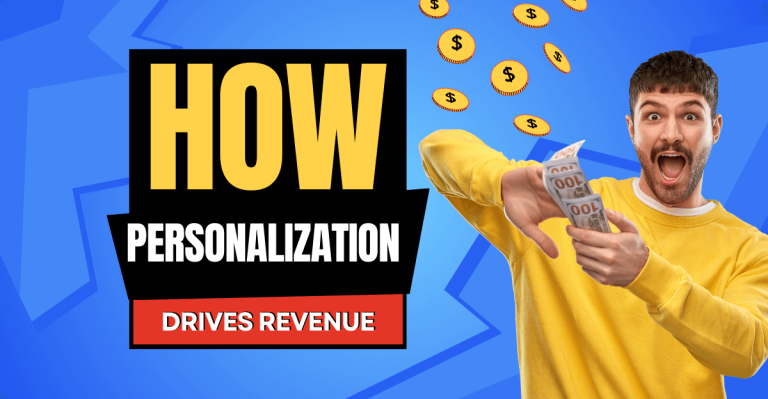Why This Question Matters
Email is Powerful—But Also Regulated
With ad costs rising and cookies disappearing, email is becoming more valuable than ever. But unlike ads, email is a direct form of communication and it’s legally protected.
Ecommerce Brands Must Balance ROI with Compliance
Sending emails without consent might bring short-term wins, but long-term consequences include:
- Spam complaints
- Legal penalties
- Damaged sender reputation
Understanding the Types of Consent

Express Consent (Opt-In)
A user explicitly subscribes to marketing emails by:
- Checking a box
- Filling out a form
- Confirming via double opt-in
This is the gold standard globally.
Implied Consent (Soft Opt-In)
You can send emails based on an existing customer relationship if:
- The customer bought something from you
- You’re marketing similar products or services
- You gave the customer a clear opportunity to opt out
Allowed in EU, UK, and some other countries.
Legitimate Interest (Under GDPR)
A legal basis where you can process data without consent, if:
- The purpose benefits both parties
- It doesn’t override the individual’s rights
- You conduct a Legitimate Interest Assessment (LIA)
Useful for re-engagement, B2B outreach, or low-risk marketing.
Legal Breakdown by Region: Can You Email Without Consent?
🇺🇸 United States (CAN-SPAM Act)
✅ Allowed with conditions:
- No prior opt-in needed
- Must include an unsubscribe link
- Must identify your business clearly
- Must honor opt-outs promptly
Great for B2B or post-purchase follow-ups.
🇪🇺 European Union (GDPR + ePrivacy Directive)
❌ Not allowed unless:
- You have explicit consent
- Or you use a “soft opt-in” for existing customers
- You provide a clear opt-out in every email
Heavy penalties for violations (up to €20M or 4% of global turnover).
🇬🇧 United Kingdom (UK GDPR + PECR)
❌ Same as EU:
- Opt-in required
- Soft opt-in permitted for existing buyers
- B2B cold outreach may be allowed under certain conditions
🇨🇦 Canada (CASL)
❌ Very strict:
- Express or implied consent required
- Implied consent only valid for 2 years after purchase or inquiry
- Violators face fines up to $10M CAD
Avoid emailing Canadians without clear permission.
🇦🇺 Australia (Spam Act 2003)
❌ Consent required:
- Can be express or inferred
- Clear unsubscribe link mandatory
- Fines apply for breaches
🌍 Other Notable Regions
| Country | Consent Required? |
|---|---|
| Brazil (LGPD) | Yes – similar to GDPR |
| India (DPDP) | Implied consent acceptable (currently evolving) |
| South Africa (POPIA) | Yes – express consent recommended |
Use Cases: When Promotional Emails Without Opt-In May Be Allowed
Existing Customers and Similar Products
Soft opt-in applies only if:
- The product is related
- Email was obtained during the sale
- Opt-out was clearly offered
B2B Contacts with Public Emails
In the US, UK, and some EU markets, it may be legal to contact:
- Business emails listed publicly
- People who’ve interacted with your brand
But always include opt-out options.
Transactional Emails with Upsell Opportunities
You can include product suggestions or loyalty links in:
- Order confirmation
- Shipping updates
- Account notifications
But don’t make these purely promotional. They must be primarily functional.
High-Risk Practices to Avoid
| Practice | Why It’s Risky |
|---|---|
| Buying or scraping email lists | Often illegal, always low-converting |
| Emailing EU/UK/Canada without opt-in | High fines, brand damage |
| Not including unsubscribe links | Triggers spam filters, violates law |
How to Send Cold Emails That Are Compliant & Effective
Use Legitimate Interest with Caution
- Only for B2B or previous buyers
- Document a Legitimate Interest Assessment (LIA)
Always Include Unsubscribe Options
Your email must include:
- Unsubscribe link
- Physical address
- Identity of the sender
Be Transparent, Relevant, and Respectful
Your message should:
- Clearly state its purpose
- Be personalized and valuable
- Avoid spammy language or images
Checklist for Legal Cold Emailing
✅ Do I have a legal basis (consent or legitimate interest)?
✅ Did I include an unsubscribe link?
✅ Am I sending to the right audience (B2B vs B2C)?
✅ Is the message relevant and respectful?
✅ Have I honored past opt-outs?
FAQs: Email Consent Laws for Ecommerce Brands
Can I cold email anyone if they’re a business?
In the US and UK—yes, with conditions. In the EU, you may still need consent.
Is soft opt-in valid forever?
No. It usually applies to contacts made in the last 12–24 months.
Are transactional emails exempt from consent?
Yes—but only if they serve a functional purpose, like order updates.
Can I rely on implied consent for SMS too?
No—SMS laws are typically stricter than email (especially in the US and Canada).
What happens if I break email laws?
You may face fines, blacklisting, or legal action—and your ESP could suspend you.
Grow with Consent, Not Conflict
Sending promotional emails without consent might feel like a shortcut—but in 2026, consent is the currency of trust. Email is still one of the most profitable ecommerce channels, but only if it’s used responsibly, transparently, and strategically.
At TheMailEffect, we help ecommerce brands build compliant, high-converting email systems that respect user privacy and drive long-term growth.




